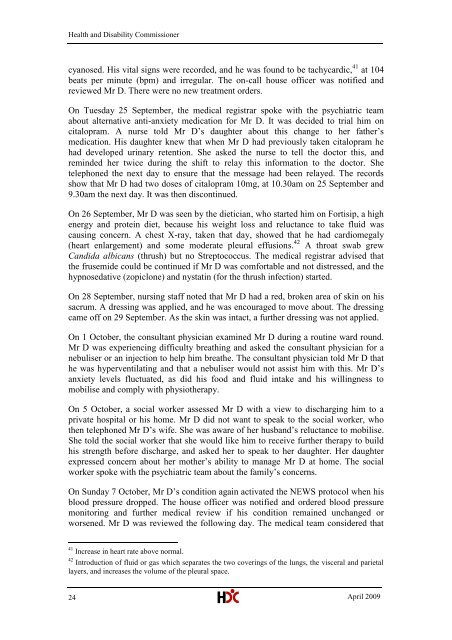North Shore Hospital report - New Zealand Doctor
North Shore Hospital report - New Zealand Doctor
North Shore Hospital report - New Zealand Doctor
Create successful ePaper yourself
Turn your PDF publications into a flip-book with our unique Google optimized e-Paper software.
Health and Disability Commissionercyanosed. His vital signs were recorded, and he was found to be tachycardic, 41 at 104beats per minute (bpm) and irregular. The on-call house officer was notified andreviewed Mr D. There were no new treatment orders.On Tuesday 25 September, the medical registrar spoke with the psychiatric teamabout alternative anti-anxiety medication for Mr D. It was decided to trial him oncitalopram. A nurse told Mr D‘s daughter about this change to her father‘smedication. His daughter knew that when Mr D had previously taken citalopram hehad developed urinary retention. She asked the nurse to tell the doctor this, andreminded her twice during the shift to relay this information to the doctor. Shetelephoned the next day to ensure that the message had been relayed. The recordsshow that Mr D had two doses of citalopram 10mg, at 10.30am on 25 September and9.30am the next day. It was then discontinued.On 26 September, Mr D was seen by the dietician, who started him on Fortisip, a highenergy and protein diet, because his weight loss and reluctance to take fluid wascausing concern. A chest X-ray, taken that day, showed that he had cardiomegaly(heart enlargement) and some moderate pleural effusions. 42 A throat swab grewCandida albicans (thrush) but no Streptococcus. The medical registrar advised thatthe frusemide could be continued if Mr D was comfortable and not distressed, and thehypnosedative (zopiclone) and nystatin (for the thrush infection) started.On 28 September, nursing staff noted that Mr D had a red, broken area of skin on hissacrum. A dressing was applied, and he was encouraged to move about. The dressingcame off on 29 September. As the skin was intact, a further dressing was not applied.On 1 October, the consultant physician examined Mr D during a routine ward round.Mr D was experiencing difficulty breathing and asked the consultant physician for anebuliser or an injection to help him breathe. The consultant physician told Mr D thathe was hyperventilating and that a nebuliser would not assist him with this. Mr D‘sanxiety levels fluctuated, as did his food and fluid intake and his willingness tomobilise and comply with physiotherapy.On 5 October, a social worker assessed Mr D with a view to discharging him to aprivate hospital or his home. Mr D did not want to speak to the social worker, whothen telephoned Mr D‘s wife. She was aware of her husband‘s reluctance to mobilise.She told the social worker that she would like him to receive further therapy to buildhis strength before discharge, and asked her to speak to her daughter. Her daughterexpressed concern about her mother‘s ability to manage Mr D at home. The socialworker spoke with the psychiatric team about the family‘s concerns.On Sunday 7 October, Mr D‘s condition again activated the NEWS protocol when hisblood pressure dropped. The house officer was notified and ordered blood pressuremonitoring and further medical review if his condition remained unchanged orworsened. Mr D was reviewed the following day. The medical team considered that41 Increase in heart rate above normal.42 Introduction of fluid or gas which separates the two coverings of the lungs, the visceral and parietallayers, and increases the volume of the pleural space.24April 2009
















